Japanese & Chinese Gardens

Harmony between man and nature - one of the themes of sustainability - was an integral part of the philosophy and way of life of the ancient cultures of Japan, China, and other far-eastern counteries. This is reflected in their traditional styles of garden design, and still has an impact on their modern societies.
Most people have a general idea of what a Japanese garden looks like, but most poeple don't realize that there are actually several distinct styles of Japanese garden. There is also a Chinese garden style, which itself contains variations.
China

After the Europeans established regular trade with China in the late 1600s, Chinese gardens became a popular theme in Europe, often juxtaposed with other garden styles. It was not uncommon to find a wooden chinese tower, bridge, or moon gate among a series of winding wooded paths. Most of these "Chinese gardens" were, in fact, mostly superficial charactures of a true Chinese garden. The Europeans copied the most obvious elements, but did not really understand the meaning behind them or the philosophical principles which were integral to true Chinese garden design.
To the early Chinese, rocks, mountains, trees, cloud, and wind were
all endowed with spirit, which to them was a type of energy that
flowed through all elements of the universe. Specific spirits were
also believed to live in wild and sacred areas, and the spirits of the
ancestors were believed to play an active role in day-to-day life. The
Taoists (pronounced "Daoists") developed an extensive theory of how
all things related to and balanced eachother. This included the theory
of the five elements, Yin and Yang, and Tai Chi (for which the martial
art was later named). The doctrine of Tai Chi stated that the universe
was constantly being created from a state of formlessness ("wu chi" -
usually, but rather inacurately translated as "the void") and
returning to a state of formlessness. This concept influenced Chinese
artists who commonly depicted mountain scenes fading into the mist,
and who in turn surely had an influence on the designers of Chinese
gardens, who attempted to copy such scenes.

Another important Chinese concept is that of the macrocosm and
microcosm. The idea is that the same elements and energies that exist
in the universe at large exist in a localized space and exist in
harmony or resonance with the universe at large. This is especially
applied in regards to the human body, a room, a city, or the garden.
Thus, the parts and rhythms of the body relate to astronomical objects
and rhythms, and dieties can inhabit distant mythical lands, mountain
tops, rocks in the garden, or places in the body. All things are
related and connected. This view has been suggested
to be consistent with the discoveries of modern physics. It is an
important aspect of Chinese garden design because the garden becomes a
microcosm of the entire world at large on more than just a symbolic
level. Rocks, water and plants balance in the same way that mountains,
oceans and forests balance.
According to the early Chinese, energy flowed, and flowed in specific ways, whether one is looking at the body or the cosmos or the landscape. To the Chinese, it was of prime importance that things were designed to be in harmony with the way energy flowed, and not working against it. From this arose the practice of Feng Shui. Designers of buildings and gardens would counult Feng Shui manuals or a Feng Shui master who would advise them as to the proper placement of rooms, paths, benches, and so on. Some elements of Feng Shuei seem to follow common sense, others would seem to us to be obscure or border on the superstitious. In any case, it was a diverse and complex art, drawing on astromomy and astrology, geometry, numerology, and philosophy - both Confucian and Taoist, and tradition.
Malicious spirits were often considered the source of troubling
events, and the Chinese garden was partly designed to purify a person
of such spirits. Tightly curving paths were a common feature of
Chinese gardens, and it was thought that malicious spirits following a
person would be lost in the twisting paths and shaken off.
Irregularity of form in itself was also a primary design principle.
Special irregular rocks, hollowed and carved by water were highly
valued and given special prominance in the garden. Smaller versions of
the "scholar
stones" (pinyin in Chinese or suiseki
in Japan) were also mounted and displayed in a way similar to bonsai.

Buddhism later arrived China from India, became integrally mingled
with the existing traditions, and eventually became the official state
religion. In garden design, it meant that Buddhist shrines came to
have a place in the landscape, and became a feature of the Chinese
garden.
All of these traditions converged and were included in the design of
the Summer Palace Gardens of Peking, constructed in the late 1600s,
the same time that Versilles was being built. This huge expanse of
manmade lakes and mountain ranges is considered the pinacle of Chinese
garden design and was the principal example which influenced the
European conception of the Chinese garden.
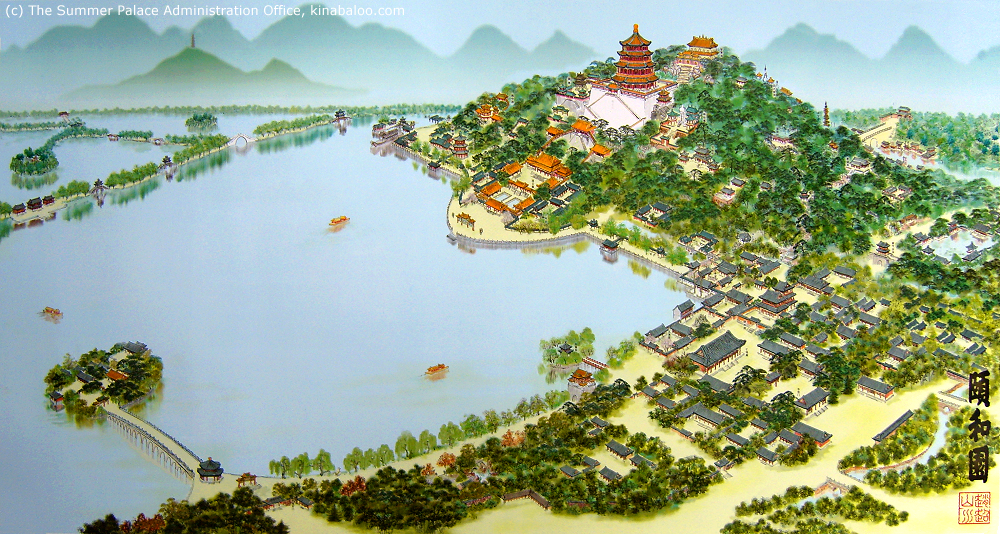
There were also numerous smaller backyard "scholar's gardens" at the
time, a number of which still exist. The persuits of the scholar -
poetry, calligraphy, philosophy - were considered to be the hallmarks
of proper nobility, and the garden provided the perfect setting for
their practice, and so became a sign of social status.

The overriding feature of the palace gardens and the scholar gardens
was the creation of small peaceful spaces, conductive to study and
relaxation, created in harmony with nature. Common natural features
included ponds with carp and ducks, rocks, pines, bamboo, flowering
plum trees, magnolias, ginkgos, maples, willows, banana trees,
flowering camellia shrubs, chrysanthemums, peonies, climbing roses,
jasmine, osmanthus, lotus, and bonsai trees, which originated first in
China. Common architectural features included stone bridges, small
wooden shrines with the classical Chinese flared roof, flat and arched
wooden bridges, and the moon gate. A display of calligraphy and ink
paintings was also common in the scholar's garden.
Japan

Trade with Japan opened up much later, and today the situation with Japanese gardens in America is similar to that of the Chinese and Europeans in the 18th and 19th century. They are quite popular, but too often superficial in design or poorly executed. There are also some quite well-executed designs, by Japanese and American designers in America. Being familiar with the authentic stylistic elements of the Japanese garden, and staying stylistically consistent is one aspect to creating a successful design. Using good design principles familiar to most landscape architects - balance, contrast, form, perspective, scale, texture, movement - will also help create a well executed design. Having an understanding of Japanese philosophy and design principles as well as specific building techniques will also go a long way towards creating a more authentic Japanese garden.

To understand Japanese gardens, it is helpful to consider that Japan is an nation of mountainous islands. Rock and water - in the form of oceans and flowing streams and waterfalls - are common features of the landscape - and mountains are almost always visible. The climate is temperate and moist - somewhat comparable to Seattle - and the forests are lush - filled with pine, cedar, cypress, maple, and azalea. The ancient Shinto practices of Japan regarded all things as being endowed with spirit. Mountains and rocks were considered to be inhabited by powerful spirits, and the spirits of ancestors were everywhere. With the arrival of Buddhism, this practice was integrated, so mountains,rocks, and islands were considered dwelling places for the Buddhist dieties. Stories and legends about specific mountains, rocks, and islands were sometimes depicted in Japanese gardenscapes. This provides the backdrop for all styles of the Japanese garden.
Boating & Strolling Gardens (chisen-kaiyu-skiki)

The earliest Japanese gardens were influenced by the Chinese. Water was normally a central feature of the garden, often surrounded by a series of small hills. On larger lakes or ponds, the view was tailored towards the boaters (once a common passtime among the imperial classes) and on smaller ponds a stroll path around the pond provided points of interest for the stroller. Some gardens accomodated boaters and strollers.

An island, sometimes connected by a bridge of series of stepping stones was common, and could represent one of several mythological places that were said to be inhabited by the immortals, while the water itself was often associatee with the ocean. Thus a stroll in the garden could be equated to some degree with visiting a sacred site. Sometimes a penninsula substituted for the island. Various types of bridges (wooden and stone) and stepping stones became a standard feature of the Japanese garden.


The Paradise Garden

The paradise garden, a variation on the stroll garden, developed with the arrival of Pure Land Buddhism from China. In such a garden, a shrine to Amittaba Buddha was typically placed across the pond and viewed from the residence or main area of activity, representing the separation of the world of man and heaven (the pure land, inhabited by deities). The shrine could be visited by strolling around the pond, having a similar significance to the island garden.
The Dry Garden (karesansui & hiriniwa)
The dry garden, or flat garden, is perhaps the most well-known style of Japanese garden. In this garden, pebbles are used to suggest water, and ripples are suggested by lines made by raking. Several upright boulders are typically placed inside the pebbled area, suggesting islands. Sometimes special symbolism is associated with the boulder islands (as mentioned above), and sometimes their geometry and perspective is assigned special significance also.
The "Zen" Garden

The term "Zen garden" is often applied to the dry garden, but is actually a made-up and not-quite-accurate phrase. Some Zen schools were opposed to any type of gardens while others built gardens inside the temples. Some of these gardens were in the dry style (the invention of which predated the arrival of Zen) and were occasionally incorporated into the meditation practices, but other garden styles were also used in Zen monostaries, and not always associated with meditation. In the monastaries that did have gardens, it was more the design and maintenance of the gardens (such as raking and pruning) that served as opportunities to practice moving meditation, rather than the gardens serving as a setting for seated meditation (the glare and heat from the sun on the stones not necessarily being ideal for this activity). Dry gardens were common in private residence settings as well, and not necessarily imbued with any special mystical significance. The term "Zen Garden" itself was coined by an American woman in the mid 1900s, and is not at all used in Japan.
The fact is that several gardening styles in Japan were employed by Zen monks, and designed in accord with Zen ideals. These sought to communicate special significance and serve as a place of contemplation (the temple gardens of the monks and private gardens of the Samurai being the best examples), but many of the gardens in Japan were simply designed for pleasure. By and large, most Japanese don't consider Zen or any religion when appreciating gardens, and enjoy them the same way we do - for their beauty. Having said this, there is no doubt as to the profound influence of Zen on Japanese art, culture, and gardening. There is also something especially "Zen" about the dry style garden with its emphasis on simplicity and empty space - very similar to the well know Zen calligraphic paintings consisting of only one or a few characters on a large scroll of paper - a point that was certainly not lost on the original Zen practitioners, and was, in fact, taken to new heights in the temple setting.
Waterfall or Rock Garden

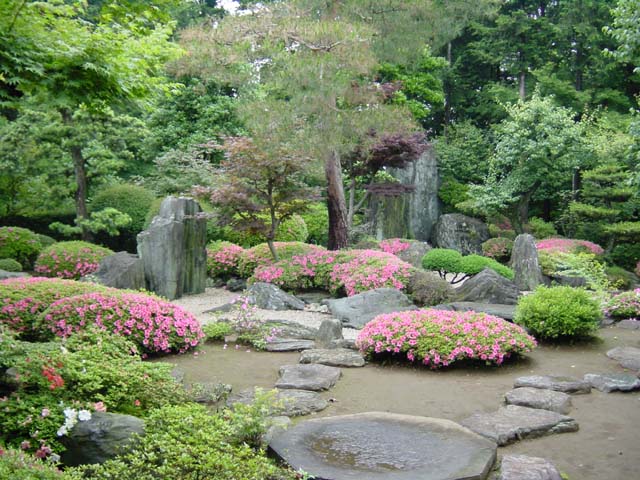
Waterfalls were a common sight in the mountains of Japan, and were regarded as a source of eternal strength. As such, they were an auspicious element to have in the garden. Waterfalls were sometimes incorporated into pond gardens or represented by rocks and gravel in the dry garden. They could also stand on their own form the focal point of a small garden. Rocks could also be placed to suggest mountains, and would sometimes be placed to echo a distant view. 3 upright rocks in close proximity also represented the Buddhist trinity.
The Moss Garden

In the temperate moist climate of Japan, moss is common and grows easily. Many gardeners have used this to their benefit by creating entire gardens of moss, which are valued for their subtle irregular rolling forms and hues of green. Some modern Japanese gardens are quite colorful, but traditionally, green was the primary color and subtle variations of hue and texture were stressed over bright color, and nowhere is this so evident as in the moss garden. In drier and sunnier parts of the world, plants resembling moss (such as Irish Moss) could be used to simulate a Japanese moss garden. Moss gardens can also be used in tandem with water or dry gardens to beautiful effect.

The Tea Garden (roji-niwa)

The tea garden is of course intimately linked with the Japanese tea ceremony, which ideally takes place in a small tea house seaparted from the main house by the tea garden. In reality, many people don't have access to a tea house or garden and perform the ceremony for their friends inside the main house. The tea ceremony is a traditional way of greeting friends and helping them relax. Besides private teahouses, there are some public teahouses and gardens in city parks, and some restaurants offer a tea garden and ceremony.
The tea garden is entered by a stepping stone path, of which there are many types. Along the way one may encounter a stone bench (Machiai) for sitting and relaxing before the ceremony starts, a bamboo grove, stone lanterns to light the way, and a stone water basin (Tsukabai) with a wooden dipper for washing. The garden is planted with a variety of plants, which are intended to instill a sense of peace through simulating the imperfect beauty of nature - a concept refered to in Japan as wabi-sabi.
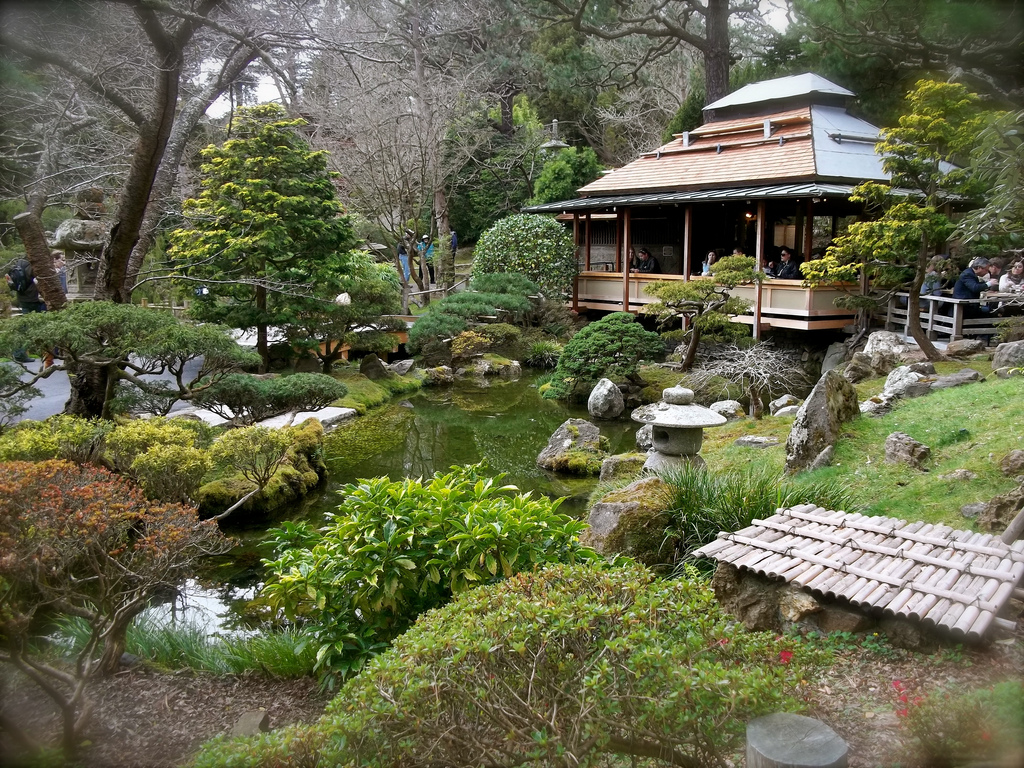
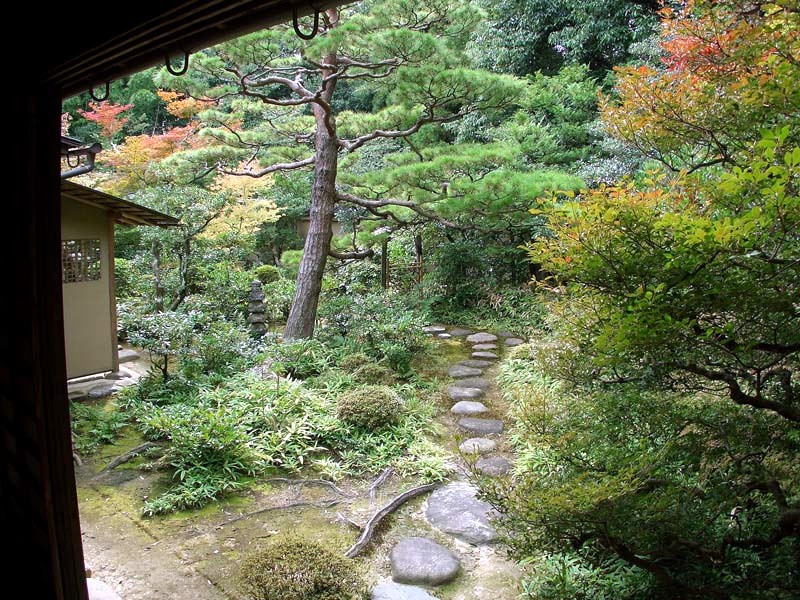
Some larger tea gardens are separated into an outer garden with mainly
deciduous plants, and an inner garden of evergreen plants, symbolizing
everlasting life. The tea house itself is, of course, in the Japanese
architectural style of wooden beams, paper pannels, bamboo slats, a
flat wooden tile roof, or flared ceramic tile roof, or possibly a
thatched roof. The inside of the house may be adorned with a few
pieces of calligraphy or brushed artwork.

Many elements of the traditional tea garden have become popularized in
Japan as well as in America, and tea garden style landscaping, having
no relation to the tea ceremony, can be found around homes and shops
in many places.
Bonsai

Bonsai - the art of growing miniature trees - is an honored artform in japan, and entire gardens or parts of gardens have been devoted to bonsai display. One mature specimen can take decades or even centuries to grow, so the individual trees and pieces can be quite valuable. The trees are grown in special containers, and can be used to accent a special spot in the garden or home. Be warned, they need special and consistent care, and do not handle neglect well.
Japanese Pruning & Topiary (Ueki no Te Ire)
Shrubs & trees can be a part of any of the various styles of Japanese garden, and be used sparsely or in great abundance. There are several styles of pruning that are used to create different effects. In one style, shrubs are sheered to resemble boulders. The form is kept somewhat irregular, in contrast to the perfect circles and ovals of formal English topiary. While there is no term for "shrub garden", this style has sometimes been used almost exclusively to create a gardenscape.

Tree Pruning (Niwaki)
In another style of pruning trees are shaped to accentuate their natural form and create a sparse windblown look. This style could be described as "giant bonsai".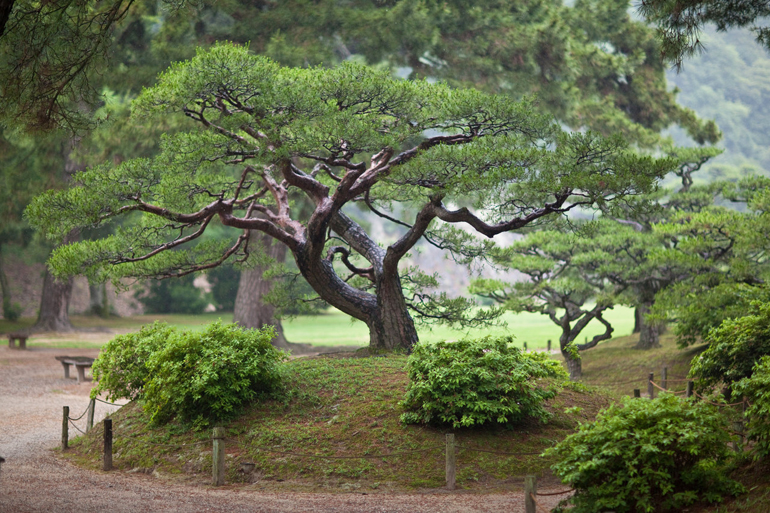

Combination Style Gardens
There is no rule against mixing and matching styles. The dry garden style is often surrounded by a moss or shrub border, while the tea garden can feature a stroll around a pond. In the amazing Adachi Gardens we can see elements of various styles being used together.





Hot Springs & Bathhouses (Onsen & Sentōs)

Being a volcanic country, hotsprings (Onsen) are a common occurance in Japan, and were historically and are currently an important part of the cultural mileau. Bathing facilities and gardens have been constructed to some degree around most of the existing hot springs, using the same style and principles that other types of japanese gardens and architecture employ. The enhanced beauty of these natural national treasures have created sanctuaries of stress releif for locals and tourists alike.

Where hotsprings are not readily available for relaxation, the Japanese have built bathhouses (sentōs) for public bathing, relaxation, and socializing. Widespread public bathing is a longstanding pilar of Japanese culture and cleanliness was a major characteristic that distinguished the Japanese from the first Europeans to land on their shores in the 1500s, who, if anything had an initial disdain for the practice.

With the advent of modern hot tubs, it is possible to bring a glimmer of the japanese onsen to your own modern gardenscape.

More Links For more inspiring photos of Japanese Gardens I recommend the following links:
- http://www.phototravels.net/kyoto/zen-gardens-index.html
- http://www.phototravels.net/japan/photo-gallery/fall-in-kyoto.html
- http://learn.bowdoin.edu/japanesegardens/gardens/intro/index.html
- http://www.orientalarchitecture.com/japan/kyoto/ginkakuji.php
- http://www.danhagerman.com/JapanPhoto.htm
Ferncreek Design & Build * Olivebridge, NY
12461
(845) 657 - 1905 * info@ferncreekDB.com
.
Serving most points within Ulster County including Samsonville,
Palentown, Krumville, Tabasco, Kerhonkson, Lyonsville, Stone Ridge,
High Falls, Alligerville, Accord, Cherrytown, Naopnach, Ellenville,
Rosendale, Tillson, Esopus, Mt Tremper, Phoenecia, Chichester, Willow,
Lake Hill, Shady, Bearsville, Woodstock, West Hurley, and Hurley. See
Service
Area Map to confirm service to your location.